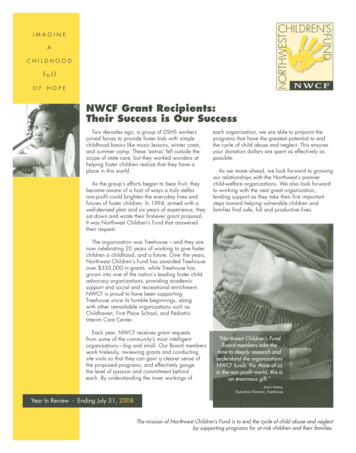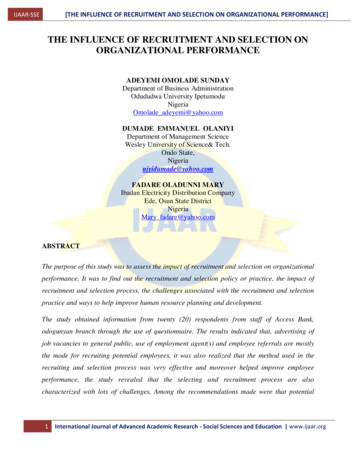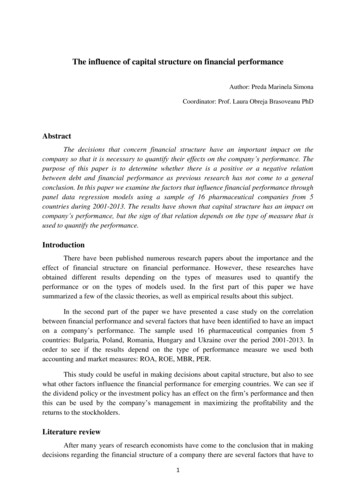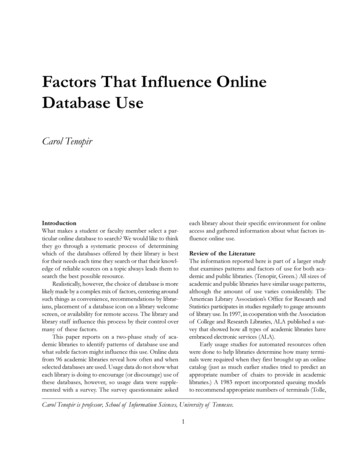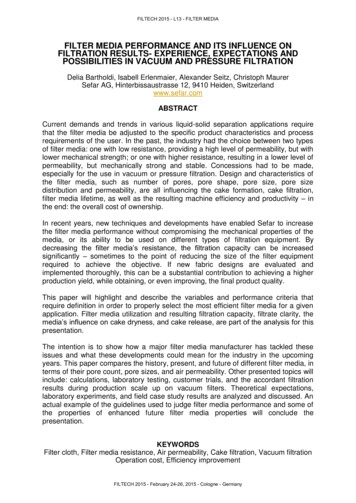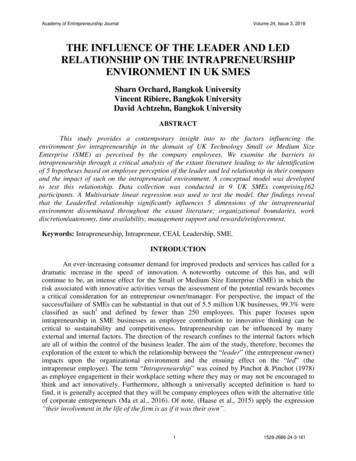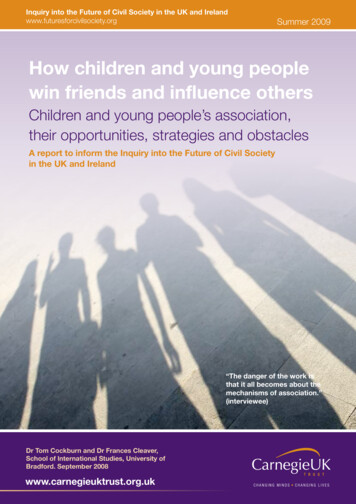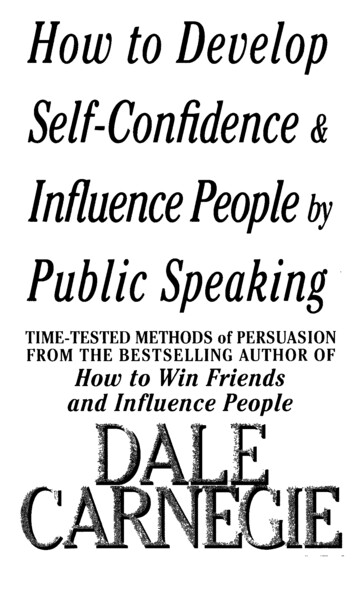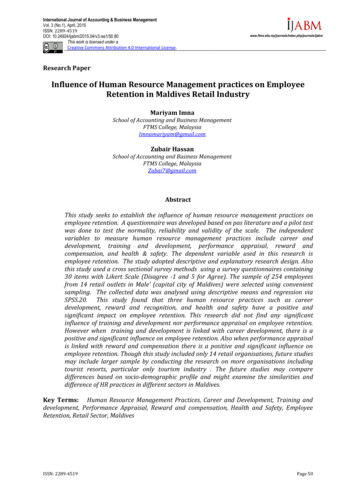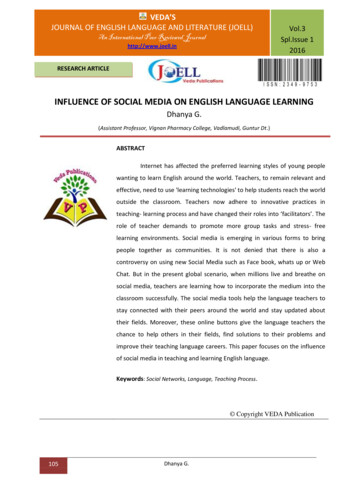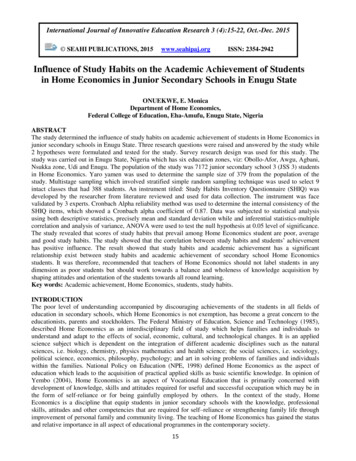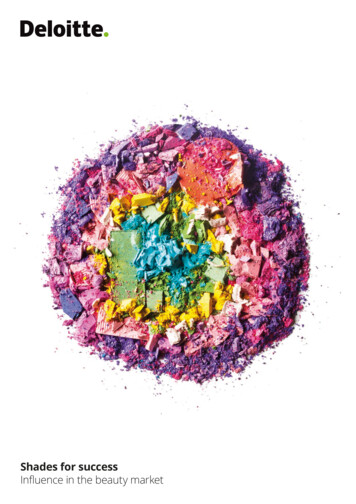
Transcription
Shades for successInfluence in the beauty market
ContentsIntroduction 01The new sources of growth 02Key players 03Inside the changing market 09The M&A surge is only beginning 12The digital drumbeat is driving change 14Appendix: The independent brands to watch 15
Shades for success Influence in the beauty marketIntroductionThe global ‘prestige’ beauty market –a broad category of overlapping premiumproducts including body‑care, make‑upand fragrances – remains one of the mostvaluable consumer business segments.Top‑line growth in prestige beauty hasoutperformed both mass market beautyand most other consumer categoriessince 2013 (Deloitte estimates globalgrowth in the prestige market to have been4.8% CAGR in 2013‑15 with total marketvalue now around 78 billion a year).At the overall market level growth has been characterised by therapid emergence of new brands, new geographic markets andnew sub-categories, all fuelled by worldwide adoption of digitaltechnologies. But at the company level this growth of digital salesand information channels over the last ten years has broughtchange and challenge, as traditional brand strategies give way toa new environment of ‘influence’ mediated by Facebook, Twitter,Snapchat and Instagram – not to mention the all‑powerful blog/vlog medium – and as established brands lose ground to upstartchallengers. The foundations of success have changed: for theleading beauty brand companies, the challenge has become oneof capturing and shaping a kaleidoscopically complex world ofinfluencers and innovators.YoY; global market size Scale of business and distribution relationships with departmentstores – formerly the primary sales channel for prestige beautyproducts – are being challenged by online sales and specialtystores, and new brands that emerge with disruptive capabilityfrom a relatively small production or market footprint. Traditional cyclical innovation in established corporate brandsand the tendency to deprioritise the historically less attractivesub-categories (e.g. masks and cleansers in skincare, browsin make-up) has given way to a rise in “sudden” agile innovationby challenger brands, leading in turn to a higher rate of creation,adoption (and sometimes rapid demise) of sub‑categorylifecycles. Traditional businesses were focussed on maximum categorypresence – being ‘everything to everyone’ within their categoryboundaries. This model may now be breaking down as themarket becomes more fragmented, and as influencers (whetherindividuals or specialty retailers) operate a pick‑and‑mixapproach to products, brands and categories. Reliance on ‘above‑the‑line’ advertising on the high street andin traditional print media, celebrity endorsements withoutengagement, and the persuasive power of in‑store beautyconsultants is giving way to a much more amorphous marketingenvironment. The new marketing embraces online opinionsharing, and rating and influencing from a diverse group ofproduct authorities who create a conversation between brandsand potential customers through social multimedia.These change factors which are visible in all geographies andmost product categories represent a classic challenge to brandincumbents. Insurgent innovators and new sources of influencehave appeared and redefined the market, enabled by changesin the way information is disseminated and shared. The newconsumer has taken control of beauty advice through social mediatutorials and online peer reviews.15%10%5%0%The leading beauty companies have already responded to thesechanges with an accelerated program of restructuring andacquisition. But this is a work in progress: much more is to come.-5%-10%The old certainties of brand power exercised through traditionalmedia have begun to break down. Brand owners now grapple witha new reality:20032005Alcoholic drinksSoft drinks20072009Home careTobacco201120132015Packaged foodBeautySource: Euromonitor, Morgan Stanley Research01
Shades for success Influence in the beauty marketThe new sources of growthNew demographicsThe demographic of beauty consumers is shifting. Firstly theyoung: millennials are projected to represent 30% of total globalretail sales by 2020. The key to capturing this generation is digitalengagement: millennials (often defined as the generation born1980‑2000) have little inhibition about using ‘digital first’ pathwaysto purchase, they actively seek out online influencers, and theyfunction in a world that is driven by image. These characteristicswill only be amplified in the post‑millennial ‘Generation Z’ oriGeneration, individuals born after the start of the internet age.But older consumers also play their part in the redefinition of themarket. Older demographic categories are adopting millennial‑likeconsumption habits: the breakdown of traditional consumer agecategories is a phenomenon of rising life expectancy and improvedlate‑life health, with the proviso that as well as ‘spending young’older consumers are also likely to spend more on niche brandstargeted at the consumer who does not want to appear old.New geographiesGlobal growth in the beauty market is concentrated in emergingeconomies. With markets in North America, developed Asia andWestern Europe all growing at 3% or less in 2010‑15, companiesneed exposure to the fast growing regions of the Middle East andAfrica (10.5%), East Asia (10%) and Latin America (9.8%), as well asEastern Europe (5.1%). Several of these new geographies are alsoemerging as sources of innovation, with South Korea for examplenow widely seen as the most innovative producer of skincareproducts. But developed markets are improving after a period oflow growth, and developed market consumers continue to havepremium spending power.New business modelsService, experience, and convenience are key to future growthin the beauty market. These factors lie behind the poor relativeperformance of traditional channels to market and the growthof digital channels (online sales despite still accounting for lessbusiness than any other traditional channel is still the only channelto have grown its share significantly since 2005). Digital hasenabled on‑demand beauty services such as US GlamSquad,BeGlammed and Vênsette, or UK Blow Ltd. It has supported thecustomer databases behind the ever‑growing range of beautybox services from low‑end Birchbox to near‑luxury Mintd. It hasenabled crowd‑funded innovation from companies like Julep andonline‑only start‑ups like cult brand Glossier.Small is the new bigGlobal brands are losing shares as small brands/disruptors are 2%23.5%10.0%9.8%23.0%9.6%22.5%201020112012Top-15 brands2013201420159.4%L&R brands (RHS)Source: Euromonitor and J.P. Morgan.The market shift to make‑upMake‑up has become the fastest‑growing beauty category since 2012,taking over from skincare. This appears to be one of the many effectsof the growing importance of digital image and opinion sharing amongconsumers of beauty products.Skincare is a higher margin business that does not lend itself so readilyto promotion via online imagery. Make‑up by contrast is primarily aboutcolour: its growth has been driven not only by smartphone technologiesthat allow colours to be virtually tested and shared, but also bydifficult‑to‑predict sub-category and trend booms including brows,contouring, and cushion foundations. Brands that are able to originateor quickly embrace new sub‑categories have demonstrated thehighest growth.However, the structure of the market is favourable for skincare in thelonger term: ageing populations will consume more skincare products,and the growth markets of Asia (excepting Korea) and Latin Americahave low per capita consumption of skincare products compared tomature markets, indicating future growth potential. The next wave ofgrowth may well be seen in the ‘hybrids’ category which blends skincareand make‑up products to deliver the immediacy of make‑up with thelong‑term benefits of pharmaceutical‑like skincare.Make-up on the upMake‑up has become the fastest growing category boosted by digital activationwhilst skin care is sagging8.0%7.0%6.0%5.0%4.0%Global growth in the beautymarket is concentrated inemerging n careSource: Euromonitor and J.P. Morgan0809101112131415
Shades for success Influence in the beauty marketKey players‘Prestige’ beauty is a fairly consolidated industry with around 45% of the marketdominated by global multinationals across the skincare, make‑up and fragrancecategories. The ranking of the world’s top beauty multinationals has changed withP&G’s sale of its beauty portfolio to Coty, making four of the five of the top businessesEuropean, with US Estée Lauder the remaining US exception.Global Brand PortfolioSkincare andCosmeticsFragrance BrandsGlobal Brand PortfolioSkincare andCosmetics03
Shades for success Influence in the beauty marketGlobal Brand PortfolioSkincare andCosmeticsAcquired 2011Acquired 2012Acquired 2013Acquired 2017Acquired 2014Acquired 2016Acquired 2014Acquired 2010Acquired 2014Acquired 2014Fragrance BrandsAcquired 2016Professional/Salon BrandsAcquired 2014Acquired 2014Beauty Retail04
Shades for success Influence in the beauty marketGlobal Brand PortfolioSkincare andCosmeticsAcquired 2015Acquired 2016Acquired 2014Acquired 2016Fragrance BrandsAcquired 2014Professional/Salon BrandsBeauty RetailGlobal Brand PortfolioSkincare andCosmeticsFragrance BrandsProfessional/Salon BrandsNoneBeauty Retail05
Shades for success Influence in the beauty marketGlobal Brand PortfolioTotal BrandsSkincare andCosmetics BrandsAcquired 2010Acquired 2000Fragrance BrandsProfessional I HairCare BrandsBeauty Retail06Other areas: Health care products/supplements (8 brands); stores and services (5 brands);Restaurants (4 brands)
Shades for success Influence in the beauty marketGlobal Brand PortfolioSkincare andCosmeticsFragrance BrandsProfessional/Salon BrandsBeauty RetailNo presence in retail07
Shades for success Influence in the beauty marketInside the changing marketDigital excellence is at the heart of change in the ‘prestige’ beautymarket. Although pure online sales still account for only a smallpart of the beauty market (with online sales accounting for 6.4%of the total market – mass and prestige – in 2015) this does notcapture the effect of online influence in the prestige market.Although the great majority of prestige beauty sales still takeplace in department stores, pharmacies and specialty stores,digital channels have become the primary arena for consumerdecision‑making. Established and challenger brands alike are nowprimarily authenticated by online influencers. Competition for newmarket share is now fought largely below‑the‑line, in the worldof online blogs and vlogs, tutorials, testing salons and consumerreviews. Challenger brands, challenger regions. Digital channels havelowered the barriers to entry into the prestige beauty market, withthe inevitable result that new brand challengers have proliferated.The replacement of pure brand power with online influencerpower has encouraged more brand switching, as has the riseof beauty box distribution and the growth of specialty retailers.Over the past few years, niche and ‘indie’ brands such as NYX,Charlotte Tilbury or Glossier have been the most importantdrivers of prestige beauty growth, encouraging more M&A fromglobal beauty brand companies as they seek to acquire small butsuccessful players to either fill in their category offers or expandinto new categories. Several challengers have emerged in Asia,the region that already accounts for 32% of the global beautymarket. South Korea is now established as the global innovationleader in skincare with brands like Tony Moly and Too Cool ForSchool registering global growth, while established regionalbrand companies like Shiseido, Kao, and Kose of Japan andAmorepacific of Korea together with local brands like ShanghaiJahwa in China and Godrej in India are growing faster than theirglobal peers. Experience & customisation. This is the age of beauty‘retailtainment’ – customers now expect peer tutorials, in‑storedigital playgrounds (found in specialist retailers such as LVMH’sSephora with its ‘Color IQ’ system, and own brand retailerssuch as KIKO Milano), make‑over mobile apps (such as theL’Oreal Makeup Genius allowing users to apply ‘looks’ virtuallyand using machine learning technology to improve productrecommendations over time). The concept of customisation isalso demonstrating a strong come‑back: although customisedskincare and make‑up is not new with Estée Lauder’sPrescriptives brand dating back to the 1970s, brand companiesfound the initial technology requirements cumbersome andexpensive. New technologies have changed that, with theemergence of applications for routine personalisation suchas the L’Oreal sun exposure monitor patch and the Kerastasesmart hairbrush, as well as tech‑enabled skin analysis products.Significantly Estée Lauder has rebooted the Prescriptives brandas a premium online service; at a lower price point brands likeMatchCo and Melange are offering on‑demand customisation.08 Convenience is a sales driver. Fast and cheap delivery and easeof access to brands seen as luxury have become increasinglyimportant to the beauty market. Exclusivity is giving way toconvenience; 81% of beauty shoppers use digital prior to orduring their shopping journey, with the majority citing “ease”as the key driver. In beauty, convenience embraces aspectslike easy‑to‑navigate stores and intuitive website layout,ease of trialling the product and getting the right advice orrecommendation quickly, allowing simplified decision‑making. Alternative distribution. Despite a relatively low share of allbeauty sales, online is the only sales channel that is growing fast.Online sales are being boosted by the rise of ‘social commerce’via the leading social media sites, and the industry is watchingclosely the performance of Amazon’s partnerships with bothlocal and multinational brands through its Beauty Channelwith its promise of super fast delivery. Regionally Asia has thelargest share of online sales, and by segment skincare is thelargest online seller, followed closely by make‑up. Within thebricks‑and‑mortar distribution segment there has also beena shift away from the traditional department store channel tofaster‑growing multi‑specialty retailers. Department stores havebeen characterised by stagnating growth and lack of investmentin digitally‑led consumer engagement, leaving specialty retailersthe most likely drivers of high street retail growth – the sales ofLVMH’s Sephora have more than doubled since 2006, while salesat Ulta have quadrupled.Although the great majority ofprestige beauty sales still takeplace in department stores,pharmacies and specialtystores, digital channels havebecome the primary arena forconsumer decision‑making.
Shades for success Influence in the beauty marketContribution from online (% of total), AmericaMEATotal2015Source: Deutsche BankContribution from online (% of total), eodorantsTotal2015Source: Deutsche Bank09
Shades for success Influence in the beauty marketCategory sales by channel, .8%5%-3.1%Grocery2015BeautyChangeSource: Deutsche Bank10-2.5-3.50%2005-1.56.4%DrugstoresDpmt storesDirectOnlineOther
Shades for success Influence in the beauty marketThe M&A surge is only beginningAs global brands are confronted with the growth of niche andindie disruptors and the likely loss of some market share to thesenew brands, acquisitions have gained popularity as a reliablesource of growth. Investors like the M&A strategy too: shareprices that were formerly closely correlated to like‑for‑like sales(a measure that excludes the impact of acquisitions) are now morelikely to respond to market share through acquisition than toorganic top‑line growth (or the lack of it). And in a changing worldwhere as many as 90% of beauty product launches fail withina year, acquisition remains the short route to maintaining a viablebrand portfolio.Top-10 beauty players losing share excluding M&A47%46%45%44%43%42%41%40%39%67Incl M&A89101112131415Ex-M&ASource: Euromonitor and J.P. Morgan. Top-10 players include: L’oréal, Unilever,P&G, EL, Coty, Beiersdorf, J&J, Avon, Shiseido and Kao. in a changing world whereas many as 90% of beautyproduct launches fail withina year, acquisition remainsthe short route to maintaininga viable brand portfolio. M&A has focused on skincare. Some of the most prominentrecent acquisitions have been targeted at category trends (suchas Korean or ‘K‑beauty’, or masks) and digital‑first disruptorsthat have been able to achieve substantial growth throughthe use of online influencers, social selling and user generatedcontent (such as L’Oreal’s purchases of NYX and IT Cosmetics,or Estée Lauder’s purchases of Becca and Too Faced). But overthe last 15 years acquisition has been heavily skewed towardsskincare, reflecting the industry’s preference for skincare’shigher margins and growth potential in an ageing global market.Unilever has been the most acquisitive of the large companiesby number of skincare acquisitions, acquiring Dollar Shave Club,Murad Skincare, Dermalogica, Kate Somerville Skincare andREN Skincare in the last two years alone, while Coty has beenthe lead acquirer by value through its acquisition of a largepackage of Procter & Gamble brands in fragrance, make‑up andhair categories, and also through its purchase of the BrazilianHypermacas body and skincare brands. Other predominantlyskincare purchases have been seen from Estée Lauder, L’Orealand Shiseido. M&A brings reputational risks. Challenger brand acquisitioncan be a minefield for established companies. Where newbrands have evolved without the kind of strict governance thatis normal in large companies, challenger companies may carryreputational issues that can be amplified by the very influencercommunity they depend upon. Recent examples include Julepwhich was fined 3 million in 2016 for miss‑selling (by using theso‑called ‘negative option’ marketing technique); Tarte Cosmeticswhich was sold to Kose of Japan but then suffered an influencerbacklash because of the Japanese company’s animal testingpractices; and Honest Beauty which has faced lawsuits overallegedly ‘faulty’ products and accusations of exaggeratedmarketing claims.11
Shades for success Influence in the beauty marketGlobal M&A deals in Beauty & PC, 2015-2016DateTargetCurrencyPending L’OréalAtelierCologne n/an/an/aPrestige fragrancesDec-16RevlonElizabethArden 8700.9-6.2Prestige and luxury fragrances, skincare,make-upOct-16ShiseidoP&G: Dolce &Gabbana n/an/an/aPrestige clothing, bags, sunglasses, fragrancesand cosmeticsOct-16CotyP&G BeautyBrands 12,5001.310.4Fragrance, make-up and hair colourJul-16L’OréalIT Cosmetics 1,2006.6n/aSkincare and make-up from TSG ConsumerPartnersJul-16UnileverDollar ShaveClub 1,0006.6n/aShaving and groomingJul-16J&JVogueInternational 3,30011.0n/aHair care business with natural positioningJun-16CounterBrandsLVMH n/an/an/aSold Nude make-up brands and skincareJun-16ShiseidoGurwitchacquisition 2402.2n/aLaura Mercier, Prestige make-up and skincare, ReVive, Prestige skin careFeb-16CotyHypermarcasBrands 1,0003.9n/aBrazilian Body, Hair, Female Deo, Nail and SkinDec-15Strengthof NatureUnilever n/an/an/aSale of 5 brands (Motions, Just for Me,Consort, Groom&Clean, TCB)Dec-15Estee Lauder Have & Be Co n/an/an/aKorean SkincareSep-15UnileverMuradSkincare n/an/an/aClinical and holistic skincare productsAug-15CVC CapitalDouglasHolding 2,8691.112.0Fragrances and make-up retailerAug-15UnileverDerm
However, the structure of the market is favourable for skincare in the longer term: ageing populations will consume more skincare products, and the growth markets of Asia (excepting Korea) and Latin America have low per capita consumption of skincare products compared to mature markets, indicating future growth potential. The next wave of
